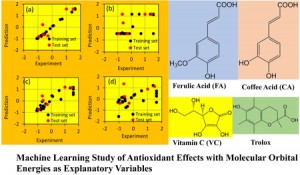[Published online Journal of Computer Chemistry, Japan Vol.21, 103-105, by J-STAGE]
<Title:> 分子軌道エネルギーを説明変数とした機械学習
<Author(s):> 寺前 裕之, 玄 美燕, 高山 淳, 岡﨑 真理, 坂本 武史
<Corresponding author E-Mill:> teramae(at)gmail.com
<Abstract:> The values of the DPPH free radical scavenging ability values (IC50) of ferulic acid and its derivatives have been estimated by machine learning with only molecular orbital (MO) energies as the explanatory variables. We use four machine learning regression methods, Partial Least Square (pls), Random Forest (rf), Multi-Layer Perceptron Neural Network with Optional Monotonicity Constraints (monmlp) and eXtreme Gradient Boosting with Linear model (xgbLinear), using R-package caret. We use 22 molecules for the training set and 6 molecules for the test set. The root mean square (RMS) errors of predicted values for the test set are used for estimating the precision of the training. The best result is obtained by xgbLinear just using two MO energies (HOMO and LUMO). It has been proved that the IC50 values can be predicted by the molecular orbital energies only.
<Keywords:> Antioxidant effect, Radical scavenging ability, Equilibrium geometries, Eigenvalues of molecular orbital, Machine learning
<URL:> https://www.jstage.jst.go.jp/article/jccj/21/4/21_2023-0001/_article/-char/ja/
<Title:> 分子軌道エネルギーを説明変数とした機械学習
<Author(s):> 寺前 裕之, 玄 美燕, 高山 淳, 岡﨑 真理, 坂本 武史
<Corresponding author E-Mill:> teramae(at)gmail.com
<Abstract:> The values of the DPPH free radical scavenging ability values (IC50) of ferulic acid and its derivatives have been estimated by machine learning with only molecular orbital (MO) energies as the explanatory variables. We use four machine learning regression methods, Partial Least Square (pls), Random Forest (rf), Multi-Layer Perceptron Neural Network with Optional Monotonicity Constraints (monmlp) and eXtreme Gradient Boosting with Linear model (xgbLinear), using R-package caret. We use 22 molecules for the training set and 6 molecules for the test set. The root mean square (RMS) errors of predicted values for the test set are used for estimating the precision of the training. The best result is obtained by xgbLinear just using two MO energies (HOMO and LUMO). It has been proved that the IC50 values can be predicted by the molecular orbital energies only.
<Keywords:> Antioxidant effect, Radical scavenging ability, Equilibrium geometries, Eigenvalues of molecular orbital, Machine learning
<URL:> https://www.jstage.jst.go.jp/article/jccj/21/4/21_2023-0001/_article/-char/ja/
